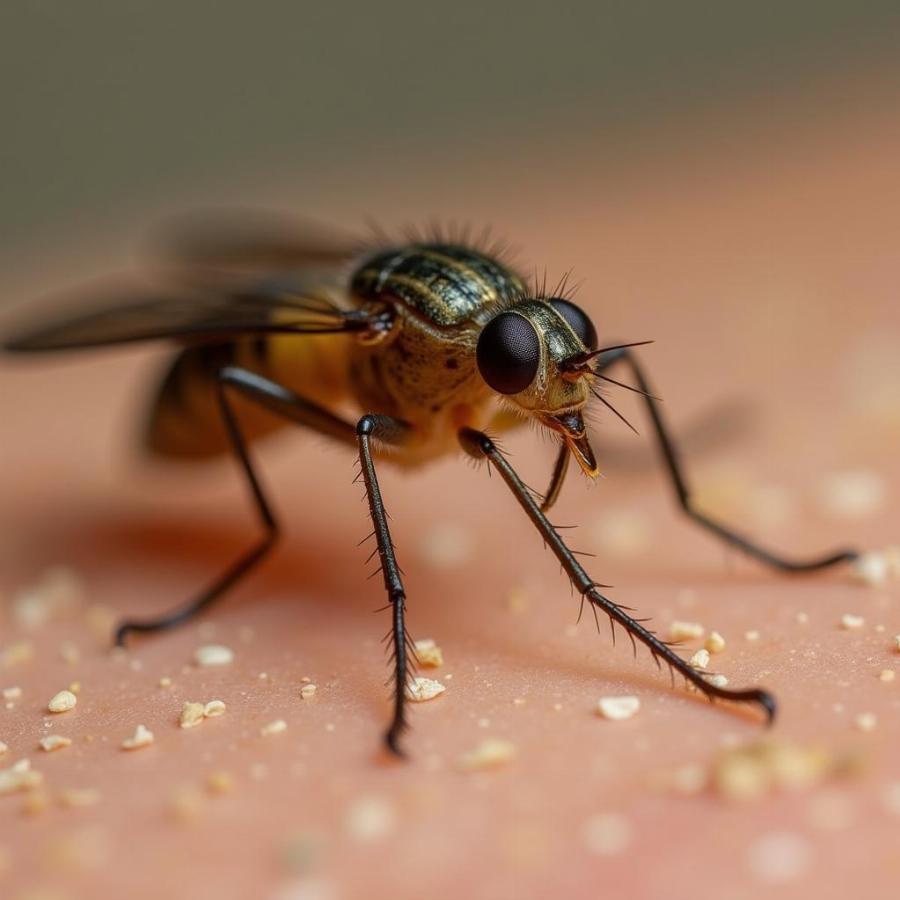Kala azar, also known as visceral leishmaniasis, is a serious parasitic disease that can affect dogs. This guide provides comprehensive information about kala azar in dogs, including its causes, symptoms, diagnosis, treatment, and prevention. Understanding this disease is crucial for every dog owner, especially those living in or traveling to areas where the disease is prevalent.
Understanding Kala Azar in Dogs
Kala azar is caused by a parasite called Leishmania, which is transmitted through the bite of infected sandflies.  Sandfly mang mầm bệnh Kala azar These tiny insects are often found in warm, humid climates. While kala azar can affect various mammals, including humans, it’s particularly devastating for dogs. The disease primarily affects the internal organs, such as the liver, spleen, and bone marrow, and if left untreated, it can be fatal.
Sandfly mang mầm bệnh Kala azar These tiny insects are often found in warm, humid climates. While kala azar can affect various mammals, including humans, it’s particularly devastating for dogs. The disease primarily affects the internal organs, such as the liver, spleen, and bone marrow, and if left untreated, it can be fatal.
Recognizing the Symptoms of Kala Azar
The symptoms of kala azar in dogs can vary, and the disease can sometimes be difficult to diagnose due to its slow progression and non-specific symptoms. Some common signs include weight loss despite a normal appetite, skin lesions, especially around the eyes, ears, and muzzle, hair loss, particularly around the eyes and ears, enlarged lymph nodes, fever, lethargy, and anemia. If your dog exhibits any of these symptoms, it’s crucial to consult a veterinarian immediately.
Diagnosing Kala Azar
Diagnosing kala azar requires a combination of physical examination, blood tests, and other diagnostic procedures. Your veterinarian might perform a complete blood count (CBC) to check for anemia and other blood abnormalities, a biochemistry panel to assess liver and kidney function, and specific tests to detect the Leishmania parasite, such as serological tests and PCR tests. Early diagnosis is key to improving the chances of successful treatment.
Treating Kala Azar in Dogs
While there’s no cure for kala azar, there are treatments available to manage the disease and improve the dog’s quality of life. These treatments typically involve long-term medication to control the parasite and alleviate the symptoms. The specific treatment protocol will depend on the severity of the disease and your dog’s overall health. Regular monitoring and follow-up appointments with your veterinarian are essential to track the effectiveness of the treatment and adjust it as needed.
Preventing Kala Azar
Preventing kala azar primarily involves protecting your dog from sandfly bites. This can be achieved through the use of insecticides, especially those containing pyrethroids, and by keeping your dog indoors during peak sandfly activity, typically during dawn and dusk. There are also vaccines available in some regions that can help protect dogs against kala azar. Discuss with your veterinarian about the best preventive measures for your dog, especially if you live in or plan to travel to an area where the disease is endemic.
Conclusion
Kala azar is a severe disease that poses a significant threat to dogs. Understanding its causes, symptoms, diagnosis, treatment, and prevention is vital for every dog owner. Early diagnosis and prompt treatment are critical for managing the disease and giving your dog the best possible outcome. Remember to consult with your veterinarian if you suspect your dog might have kala azar or if you have any concerns about their health.
FAQ
-
Is kala azar contagious to humans? While humans can also contract kala azar, it’s not directly transmitted from dogs. Both humans and dogs get infected through the bite of an infected sandfly.
-
Can kala azar be cured in dogs? Unfortunately, there’s no cure for kala azar in dogs. However, with appropriate treatment and management, affected dogs can live relatively normal lives.
-
How long can a dog live with kala azar? With proper treatment and management, dogs with kala azar can live for many years, though regular monitoring and veterinary care are essential.
-
What are the long-term effects of kala azar in dogs? Even with treatment, kala azar can cause long-term health problems, including kidney damage and other organ dysfunction.
-
Are there any natural remedies for kala azar in dogs? While some natural remedies might be suggested, it’s crucial to consult with your veterinarian before using any alternative treatments. Conventional medication is currently the most effective way to manage kala azar.
-
How can I prevent my dog from getting kala azar? The best way to prevent kala azar is to protect your dog from sandfly bites using insecticides and by limiting their outdoor exposure during peak sandfly activity.